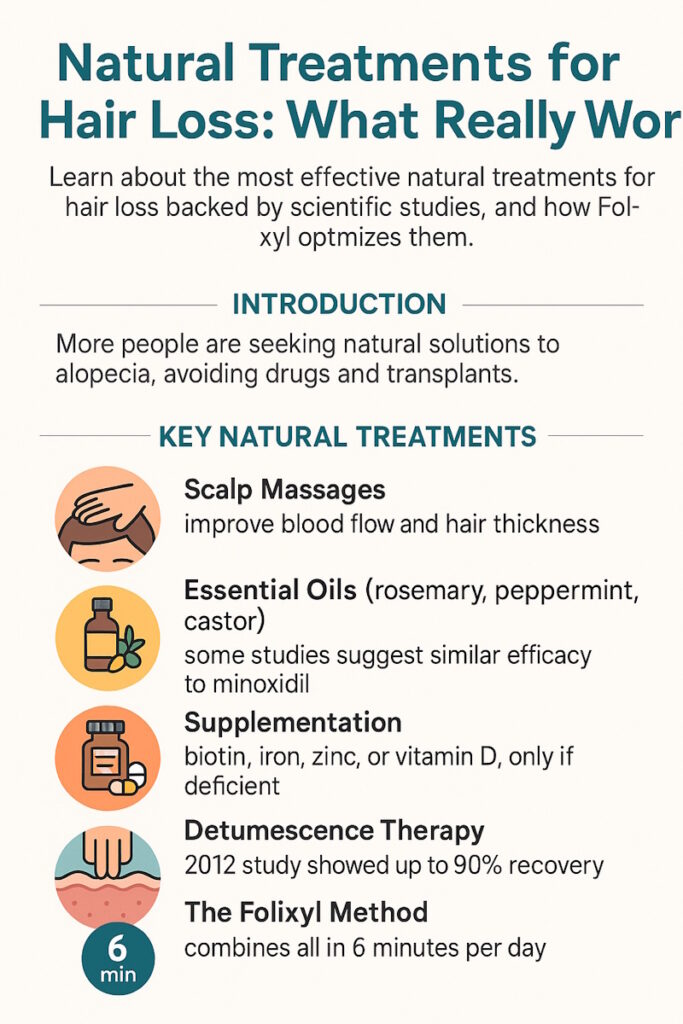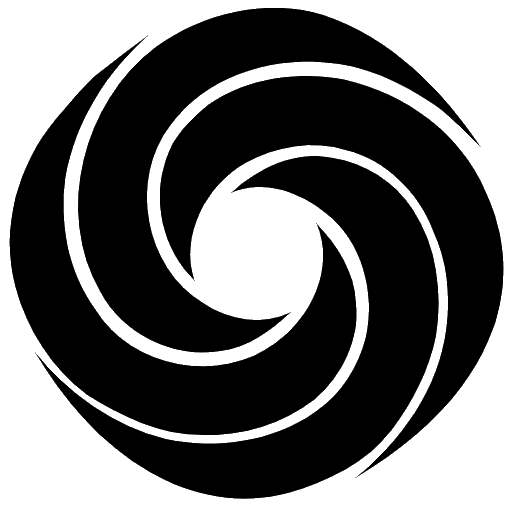More and more people are turning to natural solutions for alopecia, seeking alternatives that avoid pharmaceutical drugs and invasive hair transplants. This trend reflects not only a desire for safer options but also a growing awareness of the side effects and limitations of conventional treatments. Instead of relying solely on synthetic medications, many individuals are exploring approaches rooted in nature and supported by clinical evidence. In this article, we will review natural treatments that have demonstrated real effectiveness, helping you understand what truly works and how modern innovations like Folixyl make them more accessible.
Key Natural Treatments
- Scalp Massages:
Scalp massage is one of the oldest and simplest methods for supporting hair health. By applying consistent, gentle pressure on the scalp, circulation is improved, which enhances the delivery of oxygen and nutrients to hair follicles. Over time, this can promote stronger, thicker strands. Studies have confirmed that regular scalp massage not only improves blood flow but also encourages follicles to enter the growth phase more frequently. For many, it is a practical and relaxing habit that offers measurable benefits when done consistently. - Essential Oils (rosemary, peppermint, castor):
Certain essential oils have gained attention for their potential role in promoting hair growth. For example, rosemary oil has been studied for its ability to improve circulation and stimulate follicle activity, while peppermint oil may increase blood flow to the scalp. Castor oil, rich in ricinoleic acid, has long been used in traditional remedies to strengthen hair. Some research suggests that in specific cases, these natural oils can produce results comparable to minoxidil, a well-known pharmaceutical treatment, though typically with fewer side effects. - Supplementation:
Nutrition plays a critical role in hair growth, and deficiencies in biotin, iron, zinc, or vitamin D can negatively impact follicle strength and hair density. Supplements can be highly beneficial for individuals who are deficient in these nutrients. However, it’s important to note that supplementation is not a universal solution; it works best when addressing an actual deficiency confirmed through medical testing. When combined with a balanced diet, proper supplementation helps maintain the structural integrity of the hair shaft and supports long-term scalp health. - Detumescence Therapy:
A 2012 study highlighted the effectiveness of detumescence therapy, a technique that involves massaging the scalp to soften tissues, reduce inflammation, and restore elasticity. The results were impressive—participants showed up to 90% hair recovery in less than a year. This therapy demonstrates that hair loss can sometimes be addressed not by drugs but by directly improving the condition of the scalp environment. By reducing stiffness and improving blood circulation, detumescence creates a more favorable foundation for regrowth. - The Folixyl Method:
Folixyl integrates the benefits of all these natural approaches into one streamlined routine. Using optimized rollers, it combines mechanical stimulation, scalp massage, and circulation improvement in a process that takes only 6 minutes per day. This efficiency eliminates one of the biggest barriers to natural treatments: the time commitment. By condensing the benefits of longer massage sessions into a shorter, more practical routine, Folixyl ensures consistency and accessibility without sacrificing effectiveness.
Comparison with Medications
- Minoxidil: Widely recognized as an effective topical treatment for stimulating hair growth. However, it often comes with drawbacks, such as scalp irritation, dryness, and the requirement for lifelong use to maintain results. Stopping the treatment usually leads to renewed shedding.
- Finasteride: A prescription drug that blocks the conversion of testosterone into DHT, effectively slowing down androgenic alopecia. Despite its effectiveness, it carries risks of side effects such as reduced libido, mood changes, and hormonal imbalances, which discourage many users.
- Hair Transplants: While surgical transplants can deliver visible results, they are expensive, invasive, and require extended recovery time. Additionally, they do not stop underlying hair loss processes, meaning patients may still experience thinning in untreated areas.
In contrast, Folixyl offers a safe, non-invasive, and affordable option, combining the science behind natural therapies without the risks or limitations associated with pharmaceuticals and surgery.

Conclusion
The key to managing hair loss lies in adopting science-backed methods that are easy to sustain long-term. While natural treatments like massages, oils, and supplementation show real promise, they often demand consistency and time. Folixyl bridges this gap by reducing treatment time and removing the risks associated with drugs and surgical options. This positions it as a real and practical alternative for anyone seeking to restore hair health naturally, safely, and sustainably.
Frequently Asked Questions (FAQ)
Are essential oils enough on their own?
They can complement a broader treatment plan, but on their own, essential oils rarely produce dramatic results. They are best used as part of a combined approach that includes massage and scalp care.
What makes Folixyl different?
Folixyl combines massage, genetic stimulation, and improved circulation into a single, time-efficient process. It delivers the benefits of multiple natural therapies in just a few minutes a day, making it both practical and highly effective.
Can I use Folixyl alongside other treatments?
Yes. Folixyl is fully compatible with both natural and pharmaceutical approaches. In fact, it may enhance the effectiveness of other treatments by improving scalp health and circulation.
Do I need a medical diagnosis before starting?
A medical check-up is always recommended to rule out underlying conditions, but Folixyl is safe, non-invasive, and suitable for use without prescription.


Leave a Reply